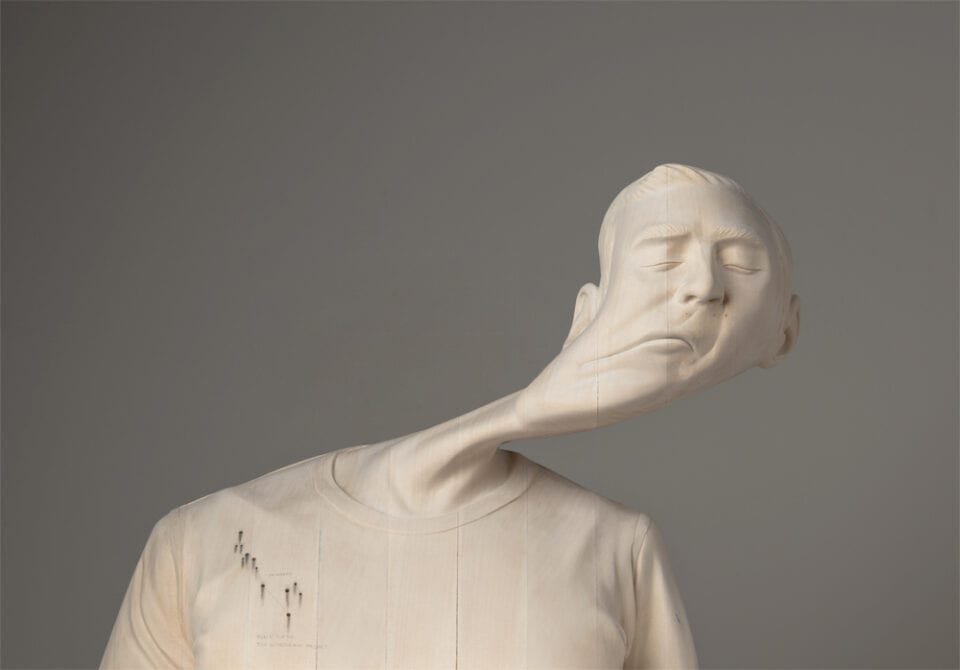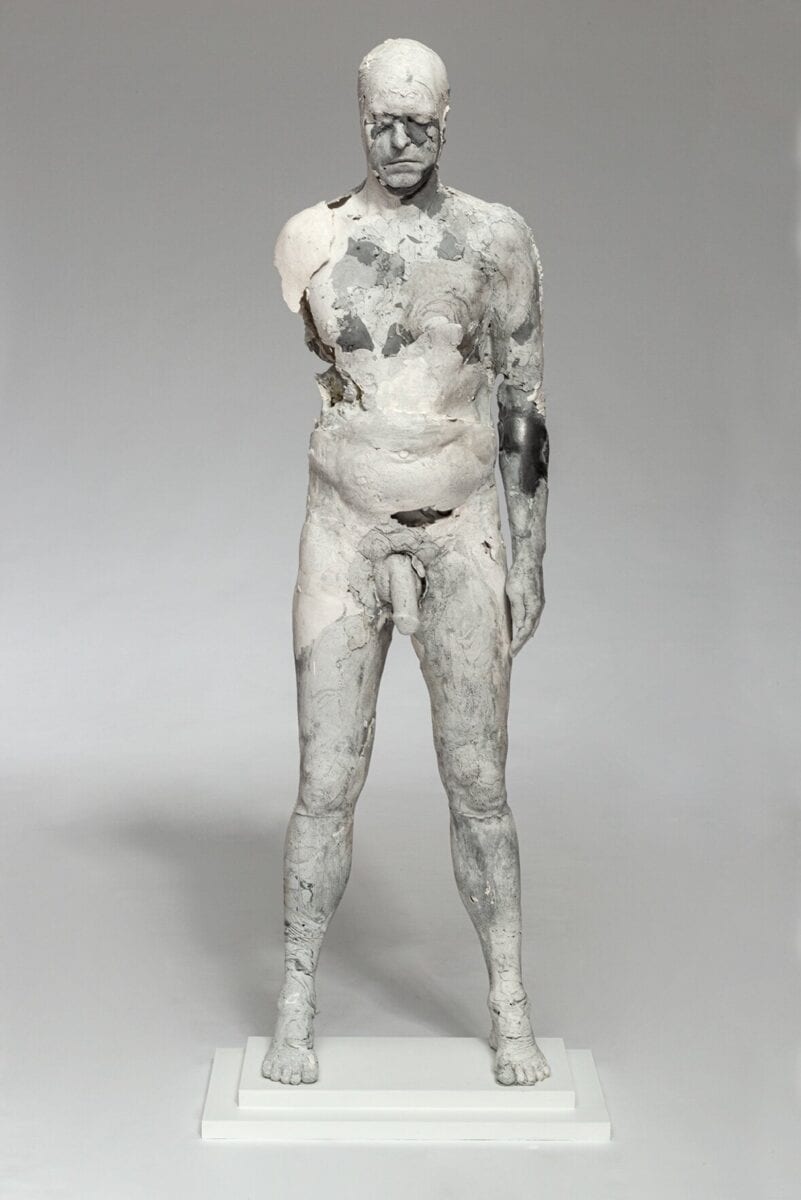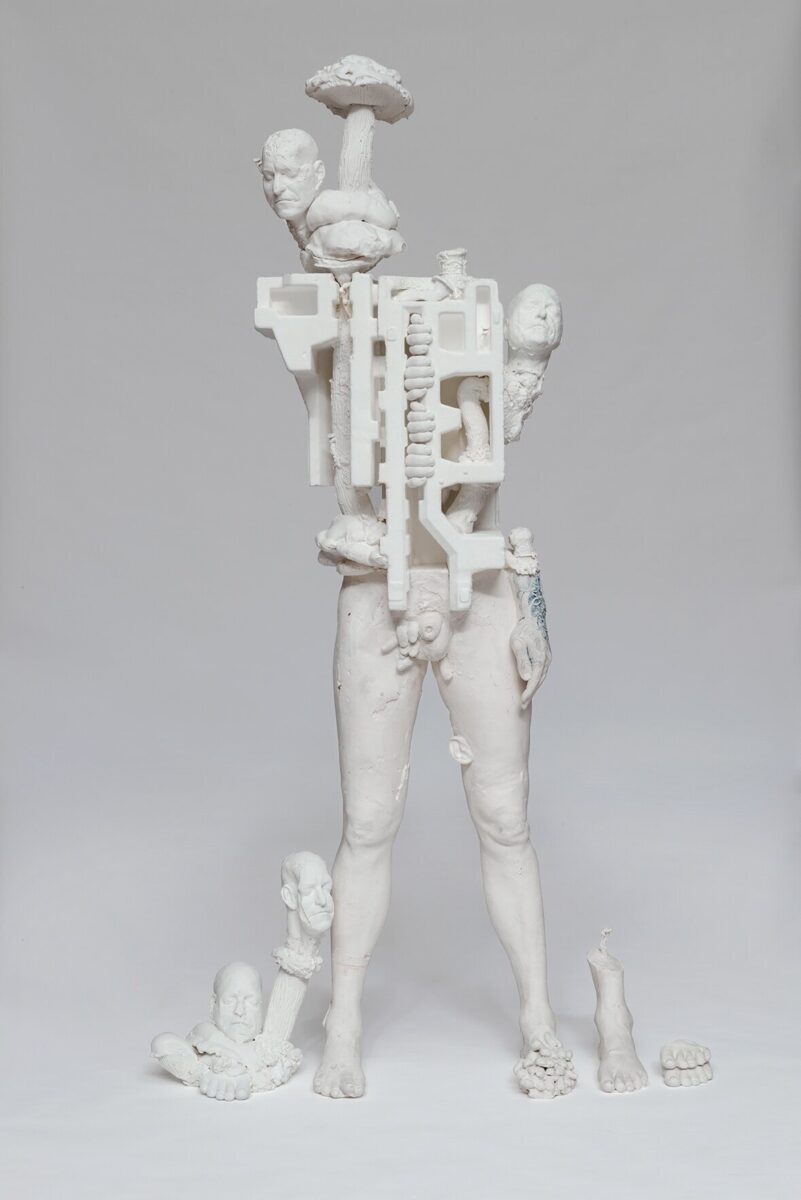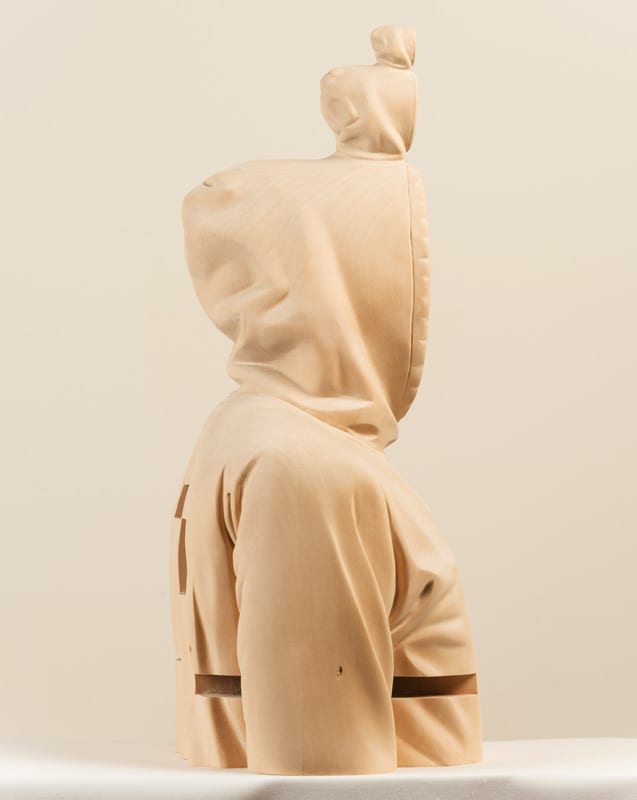2020 was a year marked by resilience, rebirth and renewal. Australian contemporary sculptor Paul Kaptein responds to our changing world through the lens of post-humanism – creating glitch-like hand carved pieces that often distort the body. In a new commission for The Syndicate, Kaptein pushes the boundaries of figuration further, creating anatomical forms that reveal themselves as fragmented, morphed, merged, remade and transformed.
A: How – and why – did you start working with sculpture?
PK: I guess it’s just the way I interpret the world. Thinking with my hands – the act of making as a way of knowing. I grew up on a small farm/orchard and often made my own toys by nailing pieces of wood and other found materials together. It’s almost like asking why I started breathing – it just happened. At art school I was determined to make as little as possible. I drew a lot though.
A: How would you describe your practice?
PK: Embodied. Sculpture is quite a physical and mental discipline. I am interested in the act of making, and the connection between mind, hand, tool and material. The process has become as important as the outcome. How is my body reacting to the contact of the material? What is that dialogue? What is the shape? What is the sound? What is the feeling? I try and observe small things that generally aren’t considered part of the process. At times, there is a dissolving of subject and object. I’ve been practicing Taoist and Buddhist forms of meditation for many years and these have influenced how I engage with the physicality and process of sculpture.

A: This series for The Syndicate marks a departure from your previous works – pushing the boundaries of figuration and abstraction. Why did you decide to take a different approach here?
PK: The way I carve wood is quite traditional – there is a movement towards a pre-determined end point or resolution. Mistakes aren’t welcome. I wanted to take a more experimental approach and, in doing so, open the door to failure to see what could emerge from that. The great thing about the Syndicate commission is that the artist is free to execute the work any way they like – the only brief is that the finished work be figurative and life sized. I explored a casting process designed around the notion of disruption, where breakages and cracks would be encouraged, overpowering and unavoidable: every rule of casting was undermined. I wanted to try and sculpt in a more musical or compositional way – in the manner of someone having a sound library at their disposal with prebuilt sounds and loops, dragging these from the library onto a timeline. I cast multiple versions of digits, arms, hands and faces. The idea was to use this approach to step outside the linear process of creating the figure. Some of the works have aspects of reverb associated with them.
A: These anatomical forms reveal themselves as “fragmented, morphed, merged, remade and transformed.” How did you achieve this effect? What materials did you use?
PK: I was drawn to the powdery, atomised nature of the gypsum as a pointer toward the materialisation of form. When mixed with water, it flows into place through swirling, flicking or throwing actions. It is quite an active agent during the casting phase – and continues to be active as cracks emerge in the drying out phase. Being brittle, it cracks easily when dropped. I dropped a lot of castings and poured over and over until I achieved an interesting result. I also disrupted the silicon moulds – a la John Cage’s prepared piano – to effect other outcomes. Expandable foam was also a worthy ally in the process; its uncontrollable nature provided a floating, voluminous and airy counterpoint to the solidity and weight of the gypsum.
A: The idea of figures “on the verge of collapse or reform” seems very timely. Do you see the works as having a connection to events going on in today’s world? What do they respond to?
PK: Back in 2017, I attended a 10-day meditation retreat. During this time, I experienced myself as an atomised entity whereby there was no distinction of internal or external boundaries. I felt like I was drifting in and out of form periodically, like I was simultaneously collapsing and reforming. It spurred an inquiry into how the body is perceived and the potentiality of the form. I was later influenced by ideas from Yuval Noah Harari’s Homo Deus around technological reliance, and how it is reshaping our modes of operation and creating new narratives. I also became interested in the Post Human aesthetic and the idea of the Post-Human body – inhabiting spaces of erasure and emptiness through this outsourcing to technology.
I wanted to explore figuration as a way arriving at new forms or potentialities through a process of breaking, disrupting and recasting. I started these works in January 2020. By the end of the year, it became quite apparent to me that, despite this project starting off as a personal response to personal experience in 2017, it had started to metaphorically resemble a collective experience as 2020 developed. A year of compression and great dismantling and rebuilding: systems of corruption, dysfunction being exposed and interrogated. Things were being broken apart, torn down and re-imagined. Failures as doorways to new potentialities, perhaps.
A: What is the significance of the title: All These Mountains Will Melt At Dawn?
PK: I was trying to write an Iambic Pentameter. Something a bit psyche meets post-rock. Something with a poetic air. For me, it speaks to the transient nature of things and perhaps also to the collapse of certainty.
A: What do you hope audiences take away from viewing the sculptures?
PK: I’ve always hoped I could dissolve the viewer a bit. That there’d be a blurring of space or distinction between viewer and sculpture.
This exhibition however, speculates on the nature of existence. Looking at aspects of bodily interventions, consciousness, ways of expanding or considering what the next stages in human evolution might be. It also attempts to dissolve the division between human and nature, or specifically the body and landscape and our relationship to the world and even the universe. I see the sculptures as both an individual and collective cosmology. Energetic systems that link the small universe of the body to the big universe of the cosmos, and back again. It posits a winding down of the anthropocentric viewpoint, considering deeper registers of time. There is also an emergence of new forms from the collapse of old structures. Spaces of change and transformation.
These Mountains Will Melt At Dawn is at OCH Gallery, 8 Phillimore St, Fremantle. 1-30 May. Find out more here.
All images courtesy Paul Kaptein.
1. From All These Mountains Will Melt At Dawn
2. From All These Mountains Will Melt At Dawn
3. From All These Mountains Will Melt At Dawn
4. WITH THE POISE OF ONE ENTERING A BLACK HOLE FOR THE THIRD TIME, 2015. Laminated, hand carved wood, graphite. h36 w44 d25 Royal Perth Hospital Collection.
5. From All These Mountains Will Melt At Dawn
6. From All These Mountains Will Melt At Dawn
7. ECHOPLASIA, 2013 laminated, hand carved wood. (Jelutong – Dyera costulata) h51 x w34 x d19 Collection of The City of Wanneroo.
8. THE ARCHIVIST, 2013 laminated, hand carved wood. (Poplar – Liriodendron tulipifera) h35 w9 d8 cm Private collection Corona, USA.











